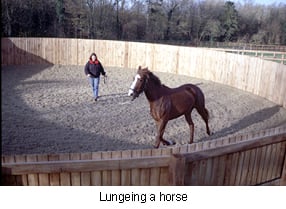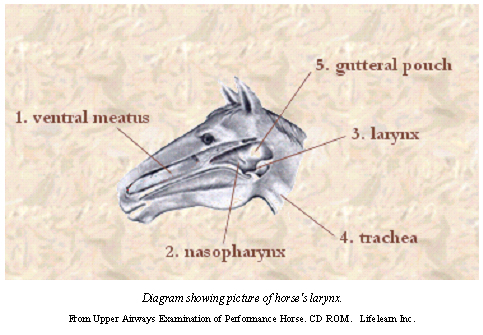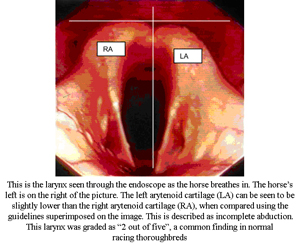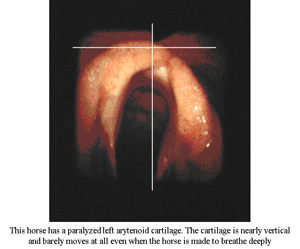Why Would An Endoscopy Be Done On An Animal?
Potential purchasers of yearlings and even foals at public sales increasingly ask for endoscopic examinations ('scoping') of the larynx and pharynx to be performed in an endeavor to assess 'soundness of current of air'. With this has come up a concomitant rise in questions and queries from vendors and purchasers akin.
What is an endoscopic exam?

Fiberoptic endoscope - this is currently the most common blazon of portable endoscope used routinely for horses. Information technology consists of a bundle of optical fibers (very narrow glass threads) inside a waterproof rubber tube. Bright light produced by a connected light source is transmitted along the fibers to illuminate the surface area of the horse to exist examined and so dorsum along the fiber bundles to the eyepiece where it is available for one person to view at a time.
Videoendoscope - these more than mod and sophisticated endoscopes have a microchip video camera at the tip of the scope. Its image is transmitted electronically back along the scope to a goggle box monitor. Ameliorate light management and reckoner applied science lead to a brighter and amend image, that can be viewed past several people at the same time on a television screen. Video sequences can be recorded and viewed later.
Within the endoscope's protective coverings are channels through which air or gas may be diddled, to expand a torso cavity so that it can be more effectively viewed and examined. There are too channels down that water can be flushed to clean the eyes in gild to go a clear pic and channels through which instruments tin exist passed to take biopsy samples (for microscopic examinations) or to snare and/or remove foreign bodies, cysts or minor tumors.
Videoendoscopes are more expensive, larger and not nearly every bit readily portable equally fiberoptic endoscopes, so their peripatetic utilize at horse sales is somewhat express. However, every bit videoendoscopes go more than bachelor at veterinary clinics, videos recorded prior to the auction are becoming increasingly normally offered by vendors for viewing at sales past potential purchasers or their veterinary advisors.
Why 'scope horses?
At the sales, the scope is used to look specifically at the structure and function of the larynx. The larynx is a circuitous valve located at the back of the throat just above the trachea ('windpipe'). The larynx is made of cartilage, musculus and nerves and is covered by a mucous membrane. It, and particularly the arytenoid cartilages that class the front of the larynx, deed every bit a valve to prevent food from being inhaled when the horse eats (it closes tightly during swallowing) while allowing the maximum amount of air to enter the lungs during exercise (information technology opens fully when the equus caballus breathes in). As well, it is the organ of voice production. While this is most important in humans it is of secondary consideration for the racehorse. 
An important and relatively mutual condition of racehorses causes the muscles of the larynx to function improperly, because the nerves that supply them go diseased. This means that the larynx cannot open fully during inspiration (breathing in). If the larynx cannot be opened fully when the horse is at practise, the horse becomes 'short of breath', and information technology'due south able-bodied performance is often significantly diminished, depending upon the type of piece of work the equus caballus has to practice. This disease has several names including "idiopathic" (that means nosotros practise not know what causes it), laryngeal hemiplegia, recurrent laryngeal neuropathy and laryngeal paralysis or paresis. Colloquially the status has been called 'whistling' or 'roaring', depending on the blazon of aberrant noise that the horse makes when it breathes in. The left side of the larynx is near commonly affected, although right-sided cases do occasionally occur. It is worth mentioning that laryngeal paralysis can exist a outcome of a number of other diseases, merely we shall concentrate on the idiopathic course most commonly seen and for which young potential racehorses are screened at sales.
How is laryngeal hemiplegia diagnosed?
The status is suspected when the horse makes an abnormal inspiratory (when the horse breathes in) noise (roaring or whistling) during strenuous exercise (on the lunge or galloping). The diagnosis is confirmed by an endoscopic exam, when the arytenoid cartilages are seen non to open properly.
What causes laryngeal hemiplegia?
The precise cause remains unknown. It appears that the nervus that supplies the laryngeal muscle, that is responsible for opening the arytenoid cartilage, becomes damaged. The nerves supplying the left and right sides of the larynx follow unlike courses although both start from the base of the brain, inside the skull. The nerve on the right travels more direct along the throat and to the muscles of the larynx. The nerve on the left side follows a considerably longer and more tortuous path; travelling down the neck and into the chest where it wraps around part of the centre before coming all the way back up to the larynx (hence its name 'left recurrent laryngeal nerve'). This long pathway is thought to predispose to degeneration within the left nerve. Hence the left side of the larynx is more commonly afflicted than the correct.
Then why is at that place controversy over 'scoping?
Unfortunately, the diagnosis of laryngeal hemiplegia is not straightforward. There is a large 'grey area' in the endoscopic advent of laryngeal function betwixt what is considered normal, and what is considered diseased.
When the larynx is viewed through an endoscope, the horse's left side appears on the correct of the prototype. The left arytenoid cartilage is carefully examined while the larynx opens and closes as the horse breathes in and out. Paralysis is seldom complete and information technology can be difficult to recognize early signs, or credible asynchronies may exist misinterpreted, leading to false positive and negative diagnoses. Even in normal horses, the left arytenoid cartilage sometimes moves more slowly than the right one. It may non move at precisely the aforementioned time or through the same range of motility as the correct-sided cartilage. Sometimes the left side opens fully but closes slightly before the contrary side. The movements of the arytenoid cartilages are therefore described in terms of synchrony and symmetry. They may be described every bit abducting (upward and outward movement) poorly or weakening prematurely.
In club to ease communication and to help observers depict and document their findings, several grading systems have evolved. Each system rates the larynx, according to how information technology 'performs' during visualization with the endoscope. A commonly used system grades a horse's larynx 'out of v': 
1. A totally normal horse in which all the movements of the larynx occur simultaneously and in complete harmony. Both sides of the larynx open fully and hold their open up position as required. In reality, this is rarely seen.
2. This larynx can do all the movements required, simply sometimes the left side moves a little subsequently than the right side. When viewed with the horse breathing quietly, it looks a little 'lop-sided' because there is 'resting disproportion'. About Thoroughbred horses autumn into this category.
three. This larynx shows premature weakening, i.e., its left side opens fully only sags downwards while the right side remains fully open.
4. The left side of the larynx cannot open (abduct) fully.

Consequently, when a veterinary examines the horse with an endoscope, he or she assigns the horse to i of these 5 categories. If the examination is beingness performed on behalf of a potential purchaser (i.e., before going through the sales band) the information is relayed to the purchaser or agent and a conclusion is made as to the horse'due south suitability for buy equally an athlete. This is where the situation becomes potentially difficult and there are several potential pitfalls:-
The appearance of the larynx volition vary slightly, even in the aforementioned horse, between examinations. This means that during 1 exam, the larynx shows no signs of abnormality but at another exam it may bear witness some premature weakening. The larynx may therefore be graded as a 'two out of 5' during ane examination and a 'three out of v' at the next, apparently 'jumping groups'.
Laryngeal disease is progressive. A purchaser may have bought a equus caballus with a 'three out of 5' larynx ane year only for it to deteriorate sufficiently to require surgery twelve months later. This is not an uncommon occurrence. This purchaser may later need that horses bought for him have 'perfect' or 'near perfect' endoscopic results earlier he considers it good enough to bid for.
Horses are usually and routinely examined at rest, whereas the existent test of its functional capacity comes when it is galloping at full speed, as in a race. The larynx works at its best (and worst) when the equus caballus is performing at maximum effort. Endoscopic examinations can be performed on a high-speed treadmill with a horse exercising at total speed and results sometimes show abnormalities that are non detectable when the horse is breathing quietly. Conversely, some horses that show signs of poor laryngeal role during routine endoscopic examinations will race well, with no credible wind issues, and when examined on a treadmill, the larynx opens fully and ordinarily. Paradoxically, some horses that perform poorly and make abnormal inspiratory noises at exercise on and off the treadmill have no demonstrable laryngeal abnormalities.
Therefore, veterinarians acting on behalf of potential purchasers try to discuss their findings cautiously, in the calorie-free of current knowledge, so that the individual can accomplish an informed conclusion. Unfortunately there is no dubiety that many perfectly able athletes are rejected on the basis of an endoscopic stance.
What about the \"wind test\" performed on behalf of the purchaser?
Horses affected with significant degrees of laryngeal hemiplegia often make an abnormal racket (a loftier pitched 'whistle' or less commonly a lower pitch 'roar') when they breathe in at fast exercise. It is important to be able to distinguish these noises from other respiratory noises caused by other throat problems, e.g., infections or simply lack of fettle.
Veterinarians who look at horses after they are sold do then on behalf of the purchaser. If a purchaser requests a 'wind test' the horse is initially examined at exercise by a veterinarian of their choice. For yearlings this involves exercising on the lunge at the sales paddocks, merely for horses in training the exam may have place on the gallops, i.e., off the sales bounds. If the equus caballus makes a suspicious inspiratory noise, information technology will exist examined with the endoscope. If a significant degree of laryngeal dysfunction is diagnosed, it will be 'returned'. These horses are then examined by 3 highly experienced veterinarians (the 'current of air panel') who act on behalf of, and are paid by, the sales company. This is important because, from this point on, the criteria laid downward in the conditions of auction become overriding factors.
The veterinarian interim on behalf of the purchaser will render a horse if there is any doubt that at that place may be a current of air problem. The panel volition only deem a horse returnable if it fulfils the conditions of the sale with respect to current of air problems i.e., that it makes a characteristic inspiratory noise and shows endoscopic signs of meaning laryngeal hemiplegia. This is not a perfect solution to the problem, but it does at least try and provide the fairest environment for both buyers and sellers. Strictly speaking, the conditions of sale refer merely to laryngeal hemiplegia, and not to any other diseases of the airways, although some may similarly adversely affect a horse's athletic power.
Some horses that have been returned post-obit the purchaser'southward veterinarian's exam and failed by the 'panel' and therefore returned to their vendors, have turned out to be successful racehorses.
Source: https://vcahospitals.com/know-your-pet/endoscopy-in-horses
Posted by: browngribetwouter.blogspot.com

0 Response to "Why Would An Endoscopy Be Done On An Animal?"
Post a Comment